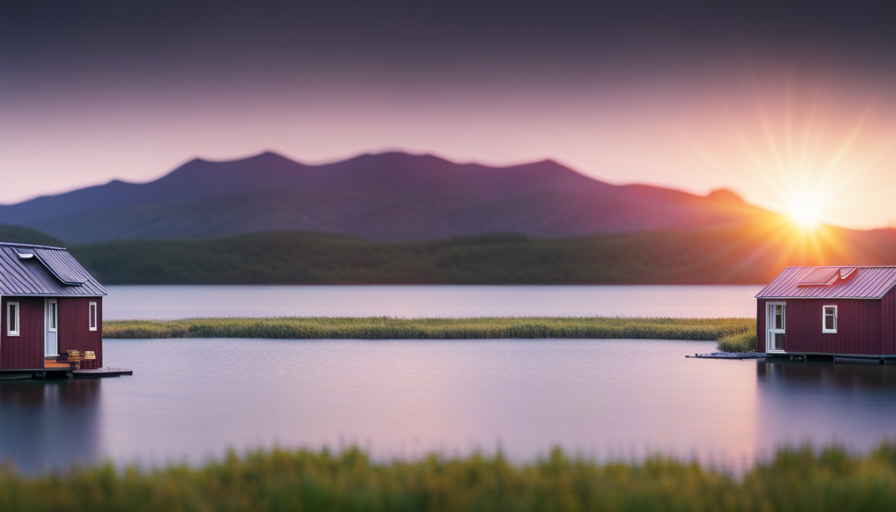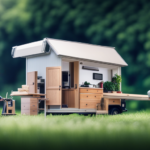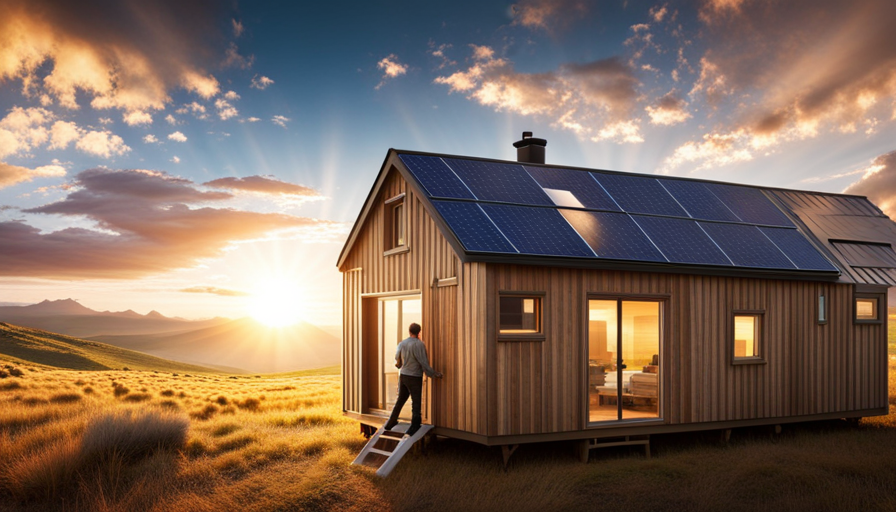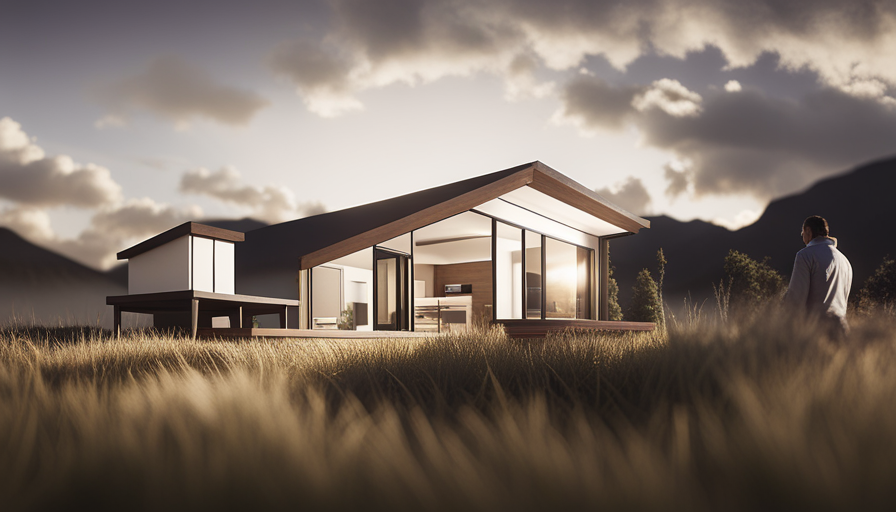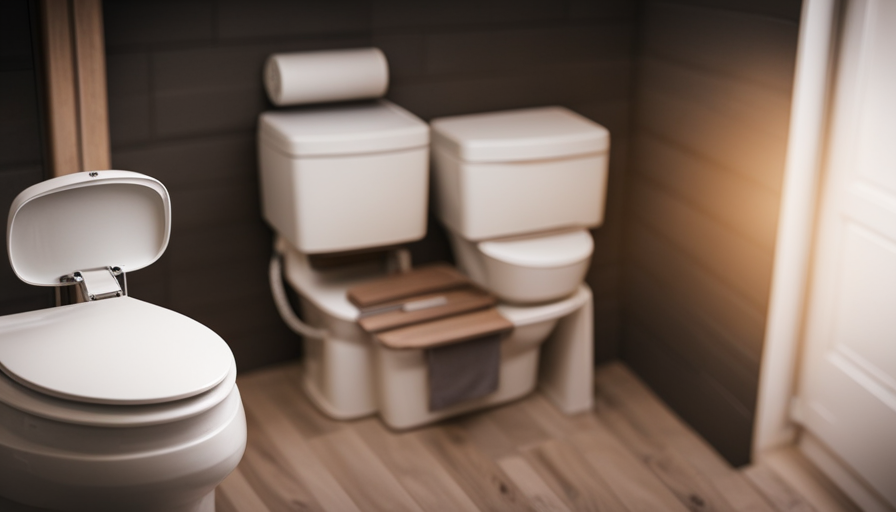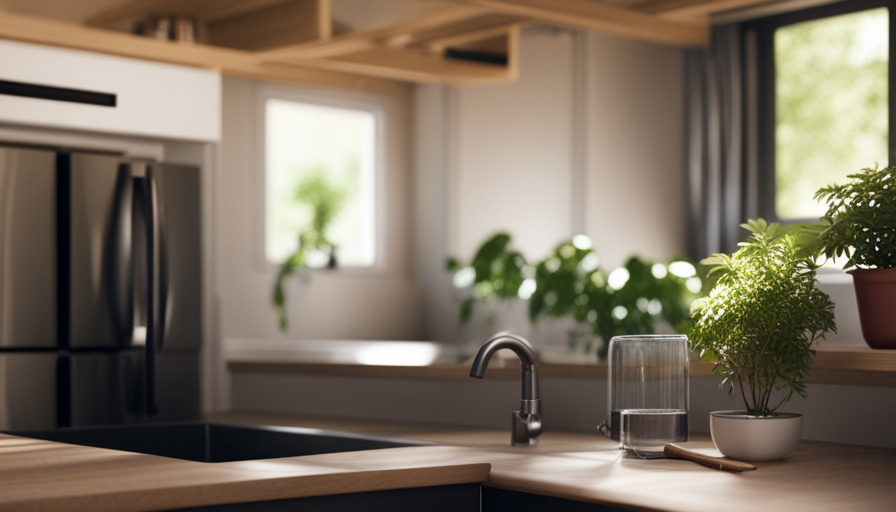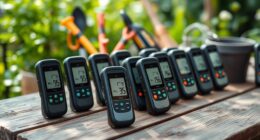Were you aware that the typical expenses associated with connecting a tiny home can vary from $5,000 to $30,000? This represents a considerable sum of money for a relatively compact dwelling area.
In this article, I will break down the various costs involved in connecting a tiny house to essential utilities, such as electricity, plumbing, water, sewer, and gas. Additionally, I will discuss permit and inspection fees, landscaping and site preparation costs, as well as miscellaneous expenses that may arise during the process.
Furthermore, I will provide insights into ongoing utility costs to help you budget effectively. By the end of this article, you will have a thorough understanding of the financial implications of hooking up a tiny house, enabling you to make informed decisions and plan accordingly.
So, let’s dive into the details and explore the costs associated with connecting your tiny house to the grid.
Key Takeaways
- The cost of hooking up a tiny house can range from $5,000 to $30,000, depending on the utilities and connections required.
- Electrical connection costs include panel upgrades and wiring installation, which can range from $1,500 to $4,500.
- Plumbing connection costs involve choosing durable materials and installing water-saving features.
- Connecting a tiny house to a natural gas or propane supply is important for heating options and gas appliances.
Electrical Connection Costs
Hooking up a tiny house to electrical power can be a bit pricy, but it’s definitely worth the investment for a cozy and convenient living space. When it comes to electrical connection costs, there are a few factors to consider.
One of the main expenses is the electrical panel upgrade. Most tiny houses require a minimum of a 100-amp service to meet the electrical code requirements. This upgrade can cost anywhere from $1,500 to $3,000, depending on the complexity of the installation and the location of the tiny house.
In addition to the panel upgrade, there are other costs to consider. You may need to hire an electrician to install the necessary wiring and outlets in your tiny house, which can range from $500 to $1,500. It’s important to note that these costs may vary depending on the size and layout of your tiny house, as well as the specific electrical code requirements in your area.
Transitioning into the subsequent section about plumbing connection costs, it’s important to also consider the expenses of connecting your tiny house to a water and sewage system.
Plumbing Connection Costs
When connecting the plumbing for your tiny house, you’ll be pleasantly surprised by how affordable it can be. Plumbing connection costs for a tiny house can vary depending on the complexity of the system and the specific requirements of your house. However, with careful planning and consideration, you can keep the costs within a reasonable range.
One important factor to consider when connecting the plumbing for your tiny house is plumbing maintenance. It’s crucial to choose high-quality materials and fixtures that are durable and easy to maintain. This will help minimize the need for costly repairs in the future and ensure the longevity of your plumbing system.
Another aspect to keep in mind is water conservation. Tiny houses often have limited water storage capacity, so it’s essential to prioritize water-saving features. Installing low-flow faucets, showerheads, and toilets can significantly reduce water consumption, saving you money on your water bills.
Transitioning into the subsequent section about water connection costs, it’s important to note that the cost of connecting your tiny house to the water supply will depend on factors such as distance from the water source, permits, and any necessary excavation work. By considering these factors and planning ahead, you can effectively manage the costs of connecting your tiny house to the water supply.
Water Connection Costs
Connecting your tiny house to the water supply can be surprisingly affordable, allowing you to enjoy the convenience of running water without breaking the bank. There are several options available for water connection, each with its own cost considerations. Here are four key factors to keep in mind:
-
Water treatment options: Depending on the quality of the water supply in your area, you may need to invest in a water treatment system. This can range from simple filters to more advanced purification systems. The cost of these options can vary significantly, so it’s important to research and choose the one that best fits your needs and budget.
-
Rainwater harvesting systems: Another cost-effective option is to install a rainwater harvesting system. This allows you to collect and store rainwater for various uses, such as flushing toilets, watering plants, and doing laundry. The initial setup cost for such a system can be relatively low, and it can help reduce your reliance on the municipal water supply.
-
Plumbing materials and labor: The cost of plumbing materials and professional installation should also be factored in. The type of pipes, fixtures, and fittings you choose can affect the overall cost. Additionally, hiring a licensed plumber to handle the installation ensures quality workmanship and compliance with local building codes.
-
Permit fees and inspections: Before connecting your tiny house to the water supply, you may need to obtain permits and undergo inspections. These fees can vary depending on your location, so it’s essential to check with the relevant authorities to understand the associated costs.
Transitioning to sewer connection costs, it’s important to consider the expenses involved in connecting your tiny house to the sewer system.
Sewer Connection Costs
One key aspect to consider when it comes to dealing with sewer connection in your tiny house is the financial burden it can place on your budget. Unlike traditional homes that have access to municipal sewer systems, tiny houses often require alternative solutions for handling waste.
One option is to install a septic system, which can be quite costly. The cost of a septic system can range from $3,000 to $7,000, depending on various factors such as the size of your tiny house and the soil conditions in your area.
Another alternative to a traditional sewer connection is a composting toilet. These toilets use natural processes to break down waste into compost, which can then be safely disposed of. Composting toilets offer a more environmentally friendly option and can cost anywhere from $500 to $2,000.
Ultimately, the choice between a septic system and a composting toilet will depend on your budget and personal preferences.
Moving forward, it’s important to consider the financial implications of gas connection costs in your tiny house, as this can also have a significant impact on your overall budget.
Gas Connection Costs
When it comes to gas connection costs for a tiny house, there are two main aspects to consider: the installation of gas lines and the connection to either a natural gas or propane supply.
The installation of gas lines involves the process of running pipes and connecting them to the main gas source. This can be a complex and potentially expensive task, as it requires professional expertise and adherence to safety regulations.
Once the lines are installed, the next step is connecting the tiny house to either a natural gas or propane supply, depending on availability in the area and personal preference. This involves installing the necessary equipment, such as a gas meter or propane tank, and ensuring proper connections are made.
These two key points are fundamental to understanding the costs and logistics of gas connection for a tiny house.
Installation of Gas Lines
Installing gas lines in a tiny house can be a bit pricey, but it’s an essential step for ensuring a cozy and functional home. Gas line installation requires compliance with specific regulations to ensure safety and efficiency. It is crucial to hire a licensed professional who can assess the house’s layout and determine the most suitable route for the gas lines.
This process involves careful planning, precise measurements, and expert knowledge of local building codes. Additionally, the cost of materials, labor, and permits should be taken into account when budgeting for gas line installation.
Once the gas lines are properly installed, the next step is connecting them to the natural gas or propane supply. This ensures that the tiny house can receive the necessary fuel for appliances such as stoves, water heaters, and furnaces.
Connection to Natural Gas or Propane Supply
To ensure a cozy and functional home, you’ll need to connect your gas lines to the natural gas or propane supply, allowing your appliances to operate efficiently and effectively.
Interestingly, nearly 60% of tiny house owners choose propane as their primary fuel source due to its versatility and convenience.
When it comes to connecting your tiny house to a natural gas or propane supply, there are a few important steps to consider. First, you’ll need to determine whether your tiny house will be connected to a natural gas line or a propane tank. Next, you’ll need to install the necessary gas lines and fittings to connect your appliances.
It’s also important to note that you’ll need to connect your tiny house to a water supply in order to ensure proper functioning of your gas appliances.
As we move into the next section about heating and cooling costs, it’s important to consider how your choice of fuel source will impact these expenses.
Heating and Cooling Costs
The cost of heating and cooling a tiny house can be quite affordable if you choose energy-efficient options. When it comes to heating, there are various system options available for tiny houses. One popular choice is a wood-burning stove, which not only provides warmth but also adds a cozy ambiance. Another option is a propane heater, which is efficient and easy to install. For those looking for a more traditional approach, electric heating systems like baseboard heaters or mini-split heat pumps can be considered.
When it comes to cooling, energy-efficient methods are crucial to keep costs down. One option is to install a ceiling fan, which can help circulate the air and provide a cool breeze. Additionally, using window shades or blinds can help block out the sun’s heat and keep the interior cool. Another option is a portable air conditioner, which can be a cost-effective choice for cooling smaller spaces.
To give you a clearer picture, here’s a table comparing different heating and cooling options for a tiny house:
| Heating Options | Cooling Options |
|---|---|
| Wood-burning stove | Ceiling fan |
| Propane heater | Window shades/blinds |
| Electric baseboard heaters | Portable air conditioner |
| Mini-split heat pumps |
With the right heating and cooling choices, you can keep your tiny house comfortable without breaking the bank. Next, we will discuss permit and inspection fees, which are important considerations when hooking up a tiny house.
Permit and Inspection Fees
When it comes to building a tiny house, one of the key steps is obtaining the necessary building permits. This involves submitting the required documents and paying the associated fees.
Once the permits are obtained, the next step is scheduling inspections to ensure that the construction meets all safety and building code requirements.
Obtaining Building Permits
Although it’s not always straightforward, obtaining building permits for a tiny house can be a crucial step in the process. It is important to navigate the maze of regulations and zoning requirements to ensure compliance with local laws. The first step in obtaining permits is to research the specific regulations for tiny houses in your area. This may involve contacting the local planning or zoning department to understand the requirements and restrictions. Once you have a clear understanding of the regulations, you can begin the application process. This typically involves submitting detailed plans and specifications for your tiny house, along with any necessary supporting documents. It’s important to be thorough and precise in your application to avoid any delays or rejections. By obtaining the necessary permits and following zoning regulations, you can ensure that your tiny house is legal and safe. With the building permits in hand, the next step is scheduling inspections to ensure that the construction meets all the necessary codes and standards.
Scheduling Inspections
Make sure you’re prepared for the next step of the process by understanding the importance of scheduling inspections for your tiny house. Scheduling delays can be frustrating, but they’re a necessary part of ensuring that your tiny house meets all the necessary safety and building code requirements.
Inspections are crucial for ensuring that your tiny house is constructed properly and meets all the necessary standards. It’s important to carefully review the inspection requirements for your area to avoid any surprises or setbacks. Building inspectors will check various aspects of your tiny house, including electrical, plumbing, and structural components, to ensure that everything is in compliance.
By scheduling inspections in a timely manner, you can avoid any potential delays in the overall process.
Now, let’s move on to the next section about landscaping and site preparation costs.
Landscaping and Site Preparation Costs
Landscaping and site prep can be costly when hooking up a tiny house, but it’s worth creating a beautiful outdoor space to complement your cozy home. Proper landscaping design is essential to maximize the functionality and aesthetics of your tiny house site.
Here are three key factors to consider when calculating landscaping and site preparation costs:
-
Grading and excavation: Leveling the land and preparing the foundation is the first step in creating a stable and safe site for your tiny house. This involves clearing debris, removing rocks and trees, and grading the land to ensure proper drainage.
-
Utility connections: Installing utilities such as water, electricity, and sewer connections is crucial for a fully functional tiny house. These costs can vary depending on the distance from existing utility lines and the complexity of the installation.
-
Outdoor amenities: Enhancing your outdoor space with amenities like a patio, deck, or garden can significantly increase the overall cost. Consider factors such as materials, labor, and any additional features you want to incorporate into your landscaping design.
As you plan your budget for hooking up a tiny house, don’t forget to factor in these landscaping and site preparation costs. Once you have determined the expenses associated with these aspects, you can move on to considering the miscellaneous expenses involved in the process.
Miscellaneous Expenses
When it comes to miscellaneous expenses for a tiny house, there are a few key points to consider.
First, storage and utility sheds are essential for keeping your belongings organized and protected. These sheds can range in cost depending on the size and materials used.
Additionally, if you plan on having outdoor amenities such as a BBQ or hot tub, you may need to budget for additional hookups to ensure they can be properly connected and used.
These expenses can add up, so it’s important to plan accordingly and factor them into your overall budget.
Storage and Utility Sheds
Setting up a tiny house often includes the expense of adding a storage or utility shed, which can cost an average of $2,000-$5,000, according to a survey conducted by Tiny House Community. These sheds provide essential storage solutions for a limited space, allowing homeowners to keep their belongings organized and easily accessible. Additionally, utility sheds can house alternative power sources such as solar panels or generators, providing off-grid capabilities for the tiny house. To further illustrate the benefits of storage and utility sheds, consider the following table:
| Benefits of Storage and Utility Sheds | Cost Range |
|---|---|
| Increased storage space | $2,000-$5,000 |
| Off-grid power options | $2,000-$5,000 |
| Protection for outdoor equipment | $2,000-$5,000 |
| Versatile usage | $2,000-$5,000 |
By investing in a storage or utility shed, tiny house owners can maximize their living space and enhance their self-sufficiency. This brings us to the next section about additional hookups for outdoor amenities (e.g., BBQ, hot tub), expanding the possibilities for a comfortable and enjoyable tiny house lifestyle.
Additional Hookups for Outdoor Amenities (e.g., BBQ, Hot Tub)
To enhance your outdoor experience, consider adding additional hookups for amenities like a BBQ or hot tub, allowing you to relax and entertain in style. Here are four outdoor entertainment options to consider:
-
BBQ hookup: Installing a gas line for your BBQ will provide a convenient and consistent fuel source. The cost of adding a BBQ hookup can range from $200 to $500, depending on the distance from your house and the complexity of the installation.
-
Hot tub hookup: If you want to enjoy the luxury of a hot tub, adding a dedicated electrical hookup is essential. The cost can vary depending on the distance and the electrical requirements of your specific hot tub model, but it typically ranges from $500 to $1,500.
-
Outdoor sound system hookup: Installing outdoor speakers and wiring can enhance your outdoor entertainment area. The cost will depend on the complexity of the system, ranging from $200 to $1,000.
-
Outdoor lighting hookup: Adding outdoor lighting not only improves the ambiance but also increases safety. The cost of installing outdoor lighting can range from $300 to $1,000, depending on the number of lights and the complexity of the wiring.
When considering these additional hookups, it’s important to keep in mind the ongoing utility costs associated with them. These costs can include gas or electricity for the BBQ, electricity for the hot tub, and electricity for the outdoor sound system and lighting.
Transitioning into the subsequent section about ongoing utility costs, it’s essential to understand the potential expenses in maintaining these outdoor amenities.
Ongoing Utility Costs
The ongoing utility costs for a tiny house can be a bit like a leaky faucet – they may seem small at first, but they can add up over time.
When it comes to a tiny house, there are a few factors that contribute to ongoing utility costs.
One of the main considerations is ongoing maintenance costs. Since tiny houses are typically built on a smaller scale, they require less maintenance compared to traditional houses. However, it’s important to factor in regular maintenance tasks such as checking for leaks, maintaining the plumbing system, and ensuring the HVAC system is functioning properly. These tasks may seem small, but they can contribute to ongoing utility costs.
Another important aspect to consider is energy efficiency. Tiny houses are known for their energy-efficient design, but it’s still essential to take energy-saving measures to keep utility costs in check. This can include using energy-efficient appliances, installing insulation, and utilizing renewable energy sources such as solar panels. By implementing these energy efficiency considerations, you can reduce the ongoing utility costs of your tiny house.
While the ongoing utility costs for a tiny house may seem insignificant, they can accumulate over time. By factoring in ongoing maintenance costs and implementing energy efficiency considerations, you can effectively manage and reduce these costs, ensuring that your tiny house remains affordable and sustainable in the long run.
Frequently Asked Questions
Are there any additional costs associated with installing solar panels for a tiny house?
Installing a battery system for a tiny house can be expensive, but it is worth it if you want to have a reliable source of energy. Solar panels are a great investment for long-term savings and environmental benefits.
How much does it cost to connect a tiny house to a propane tank for gas supply?
Connecting a tiny house to a propane tank for gas supply can be quite costly. The expenses for propane tank installation and gas supply can add up quickly, making it an expensive endeavor.
What are the costs of installing a composting toilet instead of connecting to a sewer system?
When comparing the costs of installing a composting toilet versus connecting to a sewer system, it is important to consider both the initial cost and the long-term savings. Additionally, the environmental impact of composting toilets should be taken into account.
Are there any specific regulations or permits required for hooking up a tiny house to utilities?
Yeah, there are some regulations and permits you need to consider when hooking up a tiny house to utilities. These requirements vary depending on your location and include costs for utility hookup, solar panels, propane tank, gas supply, composting toilet, sewer system, well, and water supply.
How much does it typically cost to connect a tiny house to a well for water supply?
When comparing the costs of connecting a tiny house to a well for water supply, it is important to consider the advantages and disadvantages. Factors such as drilling costs, maintenance, and water quality should be taken into account.
Conclusion
In conclusion, the cost of hooking up a tiny house can vary depending on several factors such as location, size, and specific requirements. However, one interesting statistic to note is that according to a survey conducted by the Tiny House Community, the average cost of electrical connection for a tiny house is around $3,000.
This highlights the significant expense associated with ensuring a proper electrical setup, which is essential for a comfortable living experience in a tiny house. It’s crucial to carefully consider all the necessary connections and their costs before embarking on a tiny house project.
Hi, I’m Emma. I’m the Editor in Chief of Tiny House 43, a blog all about tiny houses. While tree houses are often associated with childhood, they can be the perfect adult retreat. They offer a cozy space to relax and unwind, surrounded by nature. And since they’re typically built on stilts or raised platforms, they offer stunning views that traditional homes simply can’t match. If you’re looking for a unique and romantic getaway, a tree house tiny house might just be the perfect option.
